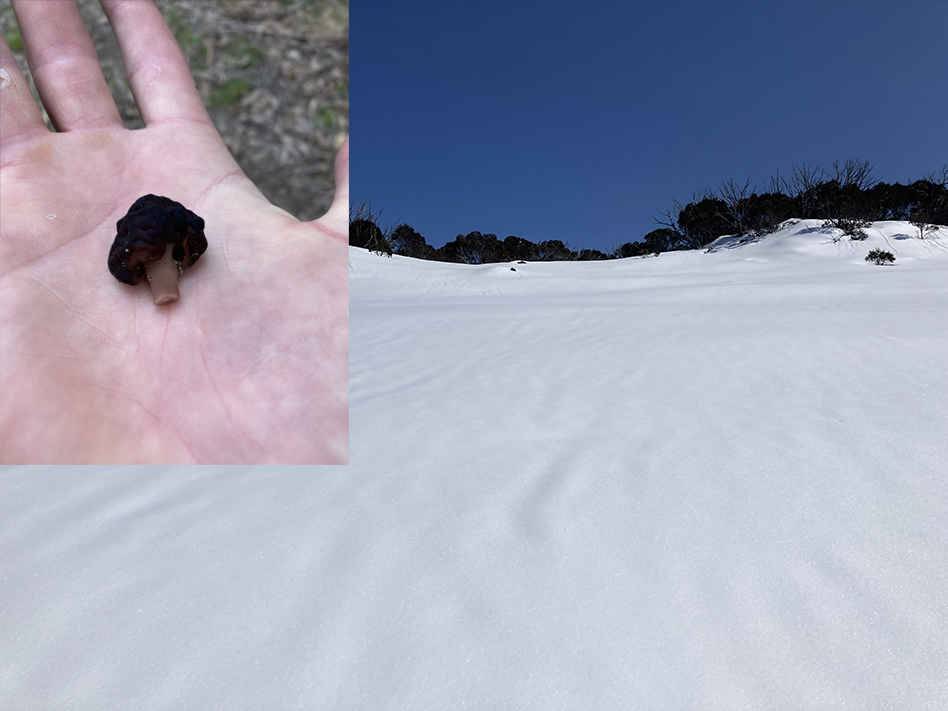(03.10.2022)
I went for a walk today up a big hill. Up out of the moisture and dampness of this little valley, to where the water runs down steep tracks, and the ground of the path gets sunlight. You can’t see it but you can feel the mycelium underfoot. The density, elasticity, and softness of the soil. It has a lot of give. It gives a lot. Particularly at the edges of the cleared path, where the moisture is held protected from the sun by the unhurried accumulation of plant matter. The shaded back of many years' growth. The mind brings the sounds of many small rustles, as well as big gusts through the valleys. It’s 11:22 am September 30 and the birds are very vocal.
I’m coming to the end of my three weeks here and reflecting on the generosity of this time spent largely in one place (albeit at 2 different altitudes). Bogong Village and Falls Creek Alpine Resort are both outcomes of the State Electricity Commission’s push into the alps, searching for energy through daming and hydroelectricity schemes. Yet these places seem so distant, so removed from the facts and experiences of power generation. It’s an interesting insight into social relations towards power and infrastructure more broadly. I’ve observed the same phenomenon in inner city suburbs; in people’s engagements with waterways. The brutal concrete infrastructure, the power pylons, the razor wire fences – these are all cut out of our photographs, cut out of our memories and experiences of a place. It's a very human (in so far as I understand the self imposed separation of much of humanity from the rest of life) trick of the mind, and one I observe as much in myself as in others. I should be clear… the dam is here, the power station is here (albeit a little hidden), the tunnels are here, the upper dam at falls and the huge pipe running the mountain is here – and visible; and yet it all feels unseen. Unreckoned with, unconsidered maybe. Certainly not by those who's years were spent toiling in the making of these significant engineering and topographic achievements, but seemingly by those whose bodies fill these places summer and winter through.
I’m not entirely sure what I'm trying to get at here, but there is something so awe-some in the way we have normalised and naturalised the power we consume and the infrastructure, interruptions, and loss that facilitate it. It seems as if people don't see the dam as an intervention, and one with consequences. Looking inwards, I’ve realised in myself that it's not a given to see things this way. The oddness or abruptness of it all might be felt, but a big layer of learned indifference sits atop that feeling. Likewise it seems taken as a simple matter of fact that at the top of the snow covered mountains there are a series of powerful chairlifts to take punters to the top of each ski run, over and over again, 8-5pm all through winter.
Thinking again about the dam. To see loss in a place, or to see a place as lacking, is not to see it or experience it in the negative. Perhaps a better framing is that of connection or care (if the word were not so art institutionally dirtied). To see a person in need is not to see them as less. If it is, then that is a failure of the one seeing. To see a place through connection is to have lived it a little. I certainly don’t make that claim to this place, but it’s nice to have passed through.
There's a sign just below where the McKay Creek and the Rocky Valley Creek meet at the entry to the Lake Guy Dam. There's a sign that mentions platypus. For many years there has been unnatural water flow down these creeks. Out of seasonal pattern, out of any pattern, and significantly variable in size, intensity, and duration. The result of upstream (and downstream) decisions on releasing water and on power generation. I am led to understand that some of this has been mitigated, mainly on the Rocky Valley Creek, through the building of a diversion tunnel for the different water flows, thus allowing the creek proper to be managed so as to emulate its natural flows as recorded before the power generation began. Still the lake fluctuates sporadically many metres over the day or days. It’s hard to imagine this place as a home to platypus, particularly when there is no shortage of un-dammed and naturally flowing waterways in close proximity. I’ve asked around and learned of a dead one washed up here at the end of summer.
At the BBQ we had, one of the residents asked another about the loch ness monster. A friend I made here answered that he’d seen it again the two nights prior. Last night he brought his thermal imaging night vision scope on a walk to the lake and can now confirm it was a live, swimming platypus – and that there were no deers in proximity to the lakes edge that night.
Image composite of undisturbed snow on a sunny day on the bogong high plains, and a small mushroom resembling a purple brown floret of cauliflower in the palm of my hand.
